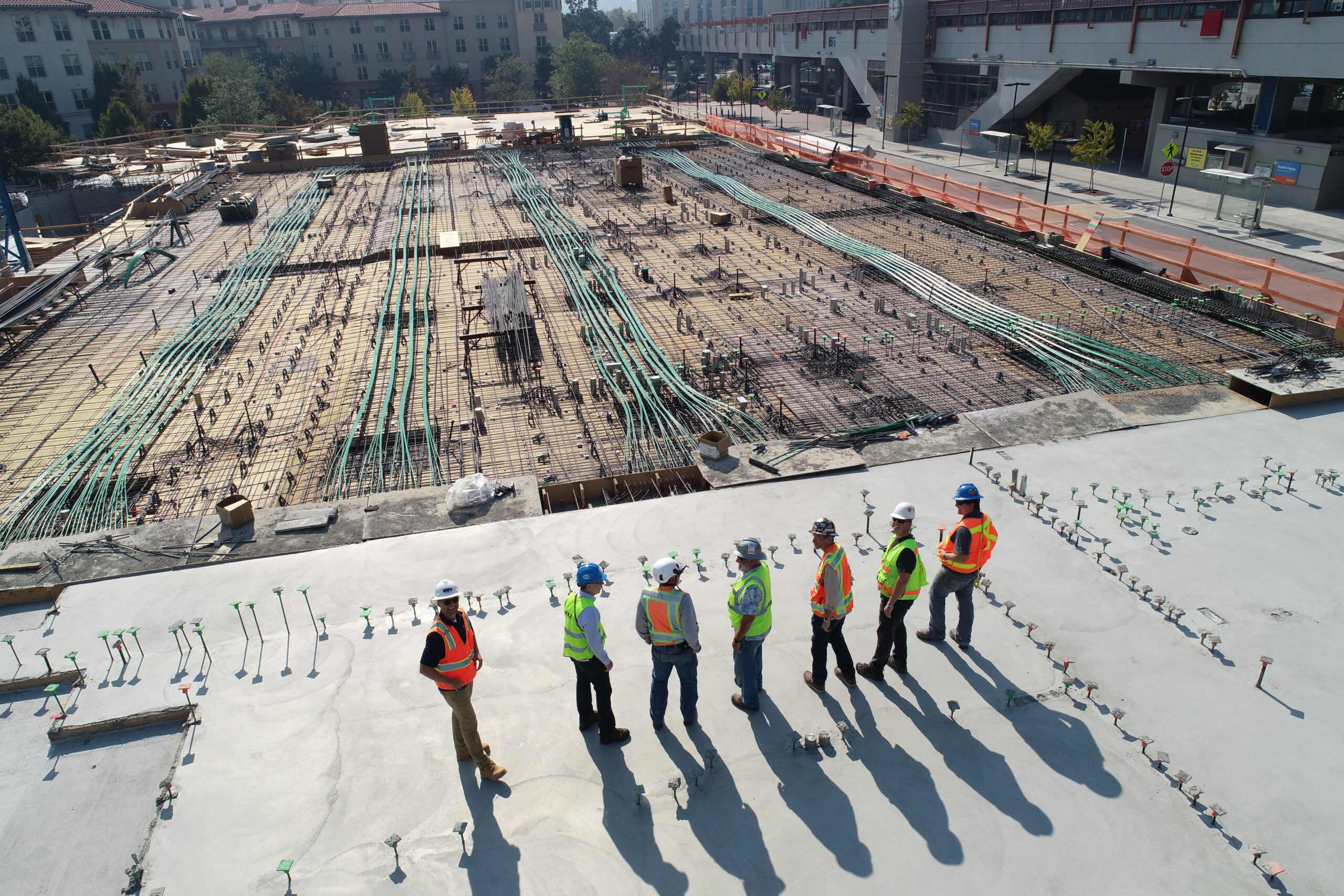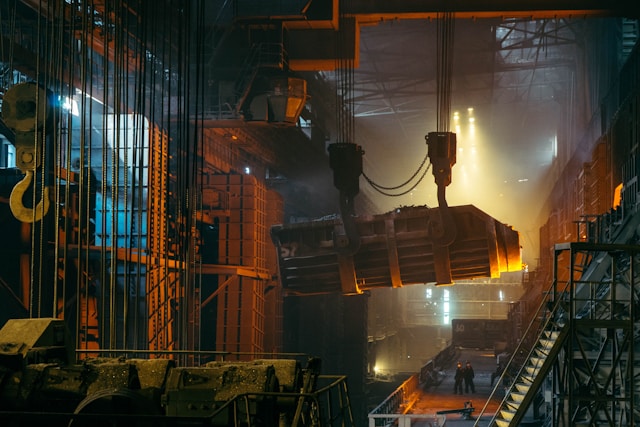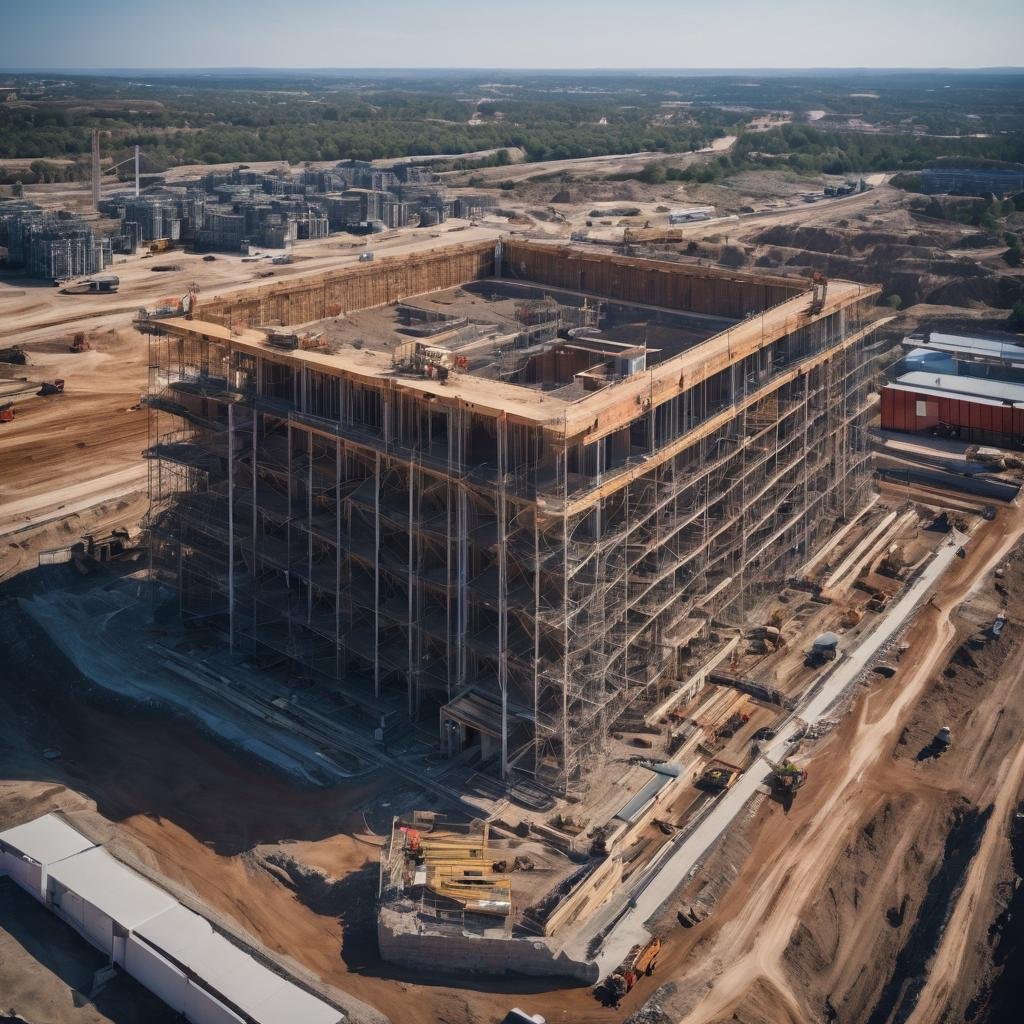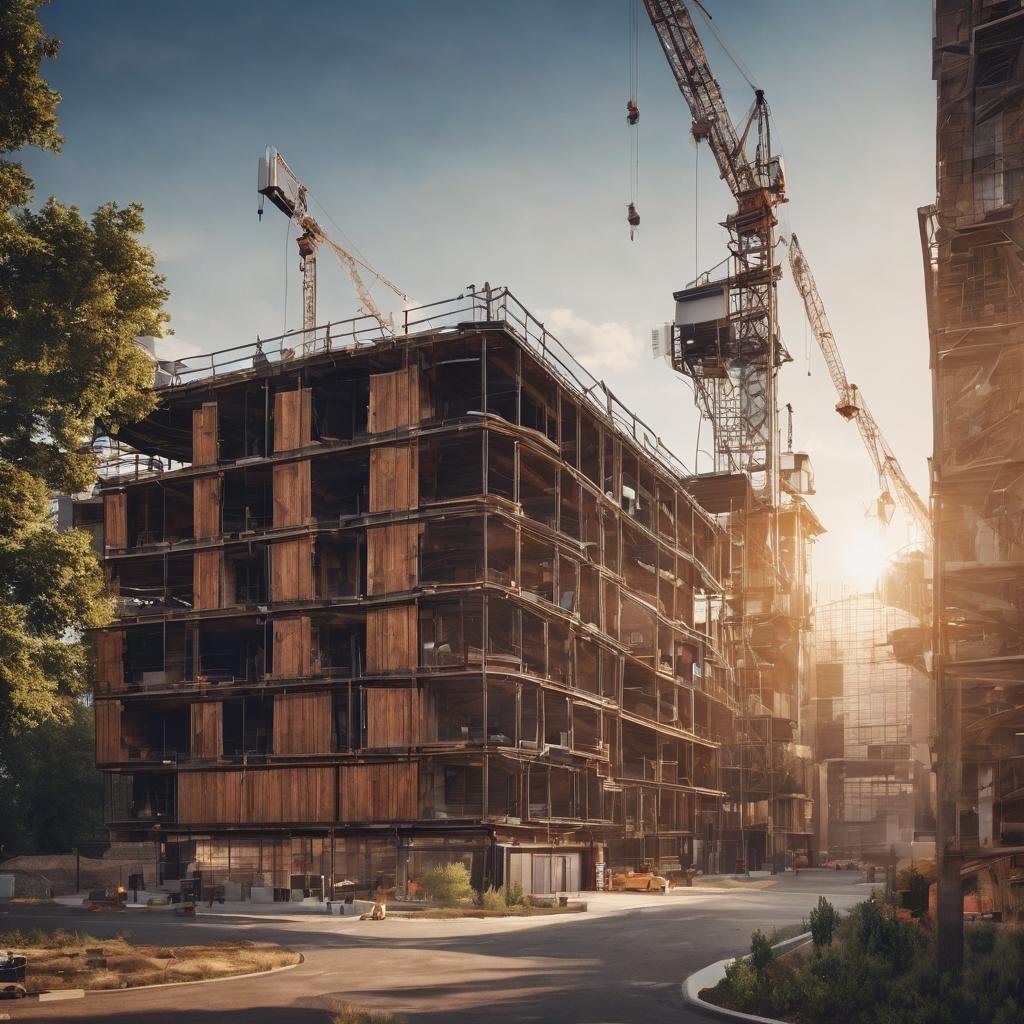Key Factors Influencing Commercial Construction Trends
Commercial construction trends are constantly evolving, shaped by a variety of key factors that influence the industry landscape. Economic conditions play a crucial role in determining the level of investment and development in the commercial construction sector. Market demand, interest rates, and overall business sentiment all contribute to shaping the direction of construction trends. Additionally, technological advancements and innovation are driving significant changes in the way commercial buildings are designed, constructed, and operated. From building information modeling (BIM) to prefabrication techniques, these advancements are reshaping the industry and driving efficiency and sustainability.
Moreover, sustainability is increasingly becoming a central focus in commercial construction trends. With growing awareness of environmental issues and the benefits of green buildings, developers and clients are placing greater emphasis on sustainable building practices. Energy-efficient designs, use of eco-friendly materials, and incorporation of renewable energy sources are now integral to the construction process. Sustainable construction not only reduces the environmental impact of buildings but also enhances their long-term value and appeal to tenants and investors.
• Economic conditions play a crucial role in determining investment and development
• Market demand, interest rates, and business sentiment shape construction trends
• Technological advancements like BIM and prefabrication are driving changes in the industry
• Sustainability is increasingly becoming a central focus in commercial construction trends
• Energy-efficient designs, eco-friendly materials, and renewable energy sources are now integral to the construction process
The Shift Towards Sustainable Building Practices
Sustainable building practices are increasingly becoming a top priority in the commercial construction industry. From reducing carbon footprints to promoting energy efficiency, businesses are recognizing the long-term benefits of investing in eco-friendly building solutions. By incorporating green materials, utilizing renewable energy sources, and implementing innovative technologies, companies can not only lower operating costs but also contribute to a more sustainable future for generations to come.
In addition to environmental benefits, sustainable building practices also offer economic advantages. Businesses that prioritize sustainability often attract a growing market of environmentally-conscious consumers and investors. By aligning with green building standards and certifications, such as LEED or BREEAM, companies can enhance their brand image, differentiate themselves in the market, and even potentially increase property values. As the demand for sustainable buildings continues to rise, embracing eco-friendly practices has become a strategic business decision for commercial developers and property owners alike.
• Sustainable building practices are increasingly becoming a top priority in the commercial construction industry.
• Businesses are recognizing the long-term benefits of investing in eco-friendly building solutions.
• Incorporating green materials, utilizing renewable energy sources, and implementing innovative technologies can lower operating costs and contribute to a more sustainable future.
• Sustainable building practices offer economic advantages by attracting environmentally-conscious consumers and investors.
• Aligning with green building standards such as LEED or BREEAM can enhance brand image, differentiate companies in the market, and potentially increase property values.
Incorporating Technology in Modern Business Architecture
In the realm of modern business architecture, the incorporation of technology has become a pivotal element in shaping the design and functionality of commercial spaces. From smart building systems to advanced surveillance technologies, businesses are leveraging tech innovations to enhance efficiency, security, and user experience within their architectural designs. The seamless integration of technology in commercial construction not only streamlines operations but also empowers businesses to stay ahead in a rapidly evolving digital landscape.
Moreover, the adoption of technology in modern business architecture is not limited to operational enhancements but extends to creating immersive and interactive environments for occupants. Virtual reality simulations, interactive displays, and IoT-powered systems are revolutionizing how businesses engage with their physical spaces, fostering a dynamic and engaging workplace experience. By blending cutting-edge technologies with architectural design principles, businesses can create environments that not only support productivity and collaboration but also resonate with the digital-savvy workforce of today.
• Virtual reality simulations and interactive displays are being used to create immersive environments for occupants
• IoT-powered systems are revolutionizing how businesses engage with their physical spaces
• Technology is enhancing efficiency, security, and user experience within architectural designs
• Businesses can stay ahead in a rapidly evolving digital landscape by incorporating technology into their architecture
Maximizing Space Efficiency in Commercial Construction
When it comes to commercial construction, maximizing space efficiency is a paramount objective for architects and developers alike. In today’s competitive market, optimizing the use of space within a commercial building can significantly impact its functionality, cost-effectiveness, and overall success. By carefully planning and designing layouts that make the most of available square footage, businesses can create environments that are not only visually appealing but also conducive to productivity and efficiency.
One common strategy for maximizing space efficiency in commercial construction is through the implementation of flexible floor plans. By designing spaces that can easily be adapted or reconfigured to suit changing needs, businesses can ensure that their buildings remain versatile and capable of accommodating different functions over time. Additionally, the strategic placement of key elements such as storage areas, workstations, and common areas can help to optimize traffic flow and create a cohesive and efficient work environment.
• Flexible floor plans allow for easy adaptation to changing needs
• Strategic placement of key elements optimizes traffic flow and efficiency in the workspace
The Rise of Mixed-Use Developments in Business Architecture
Mixed-use developments have become increasingly popular in the realm of business architecture, as they offer a dynamic and multifaceted approach to commercial spaces. Combining residential, commercial, and recreational elements within a single property, these developments create vibrant and diverse urban environments that cater to the needs of a wide range of users. By integrating different functions and amenities into one cohesive space, mixed-use developments promote convenience and accessibility for residents, workers, and visitors alike.
The rise of mixed-use developments reflects a shift towards creating more sustainable and livable urban areas. By fostering a sense of community and promoting walkability, these developments help reduce reliance on cars and encourage sustainable modes of transportation. Furthermore, the diverse mix of uses within the same area contributes to a more vibrant and resilient urban fabric, fostering economic growth and social cohesion. As businesses and developers embrace the concept of mixed-use developments, we can expect to see more innovative and integrated approaches to commercial construction in the future.
• Mixed-use developments offer a dynamic and multifaceted approach to commercial spaces
• Combining residential, commercial, and recreational elements within a single property
• Creates vibrant and diverse urban environments catering to a wide range of users
The shift towards mixed-use developments is driven by the desire to create sustainable and livable urban areas.
• Foster sense of community and promote walkability
• Reduce reliance on cars and encourage sustainable transportation
• Contribute to vibrant urban fabric, fostering economic growth and social cohesion
As businesses and developers embrace mixed-use developments, we can expect more innovative approaches in commercial construction.
Adapting to Changing Workforce Needs in Construction
In the ever-evolving landscape of commercial construction, companies are finding themselves faced with the challenge of adapting to changing workforce needs. As technology continues to advance and new generations enter the workforce, there is a growing demand for specialized skills and a shift towards digitalization within the industry. This requires companies to invest in ongoing training and development programs to equip their employees with the necessary knowledge and tools to stay competitive in the market.
Moreover, the traditional hierarchical structure of construction companies is also being reevaluated, with a greater emphasis on collaboration and cross-functional teams. As projects become more complex and require a diverse range of expertise, companies are recognizing the value of fostering a more inclusive and collaborative work environment. By promoting a culture of teamwork and open communication, companies can better harness the skills and creativity of their workforce to drive innovation and success in the highly competitive construction industry.
• Emphasize ongoing training and development programs to keep employees competitive
• Invest in specialized skills and digitalization to meet industry demands
• Foster a collaborative work environment for better project outcomes
• Promote teamwork and open communication for innovation in construction projects
Innovations in Materials and Construction Techniques
In the realm of commercial construction, the continual evolution of materials and construction techniques plays a pivotal role in shaping the landscape of modern architecture. Innovative materials such as ultra-high-performance concrete (UHPC) and cross-laminated timber (CLT) have revolutionized the way structures are designed and built, offering enhanced strength, durability, and sustainability. Moreover, advancements in prefabrication technology have streamlined construction processes, reducing build times and minimizing on-site waste.
Alongside material innovations, construction techniques have also seen remarkable progress in recent years. The adoption of Building Information Modeling (BIM) allows for detailed digital representations of a project, facilitating better collaboration among design and construction teams. Additionally, the integration of robotics and automation in construction processes has enhanced precision and efficiency, leading to higher quality outcomes and improved safety measures on construction sites. These ongoing innovations in materials and construction techniques are instrumental in driving the industry towards more sustainable, efficient, and forward-thinking practices.
• Ultra-high-performance concrete (UHPC) and cross-laminated timber (CLT) are revolutionizing modern architecture
• Enhanced strength, durability, and sustainability offered by innovative materials
• Prefabrication technology streamlining construction processes for faster build times and reduced waste
• Building Information Modeling (BIM) enabling detailed digital representations for better collaboration
• Robotics and automation improving precision, efficiency, quality outcomes, and safety measures on construction sites.
Balancing Aesthetics and Functionality in Business Architecture
Achieving a harmonious balance between aesthetics and functionality is a crucial aspect of designing successful business architecture. A visually pleasing building that lacks practicality may fail to meet the needs of its occupants, while a purely functional structure might lack character and fail to make a lasting impression. It is essential for architects and designers to carefully consider both the visual appeal and the usability of a building in order to create a space that is not only beautiful but also efficient and effective in its purpose.
Business architecture that successfully balances aesthetics and functionality is able to create a positive and productive environment for employees and visitors alike. By incorporating elements that are both visually engaging and serve a practical purpose, designers can enhance the overall experience of those interacting with the space. Whether through the use of innovative design features, efficient layout planning, or the integration of sustainable materials, finding the perfect equilibrium between aesthetics and functionality is key to creating business architecture that truly shines.
• Striking a balance between aesthetics and functionality is crucial in business architecture
• A visually pleasing building must also be practical to meet the needs of its occupants
• Purely functional structures may lack character and fail to make a lasting impression
• Architects and designers must consider both visual appeal and usability for successful design
Business architecture that successfully balances aesthetics and functionality:
• Creates a positive and productive environment for employees and visitors
• Incorporates elements that are visually engaging while serving a practical purpose
• Enhances the overall experience of those interacting with the space
• Utilizes innovative design features, efficient layout planning, and sustainable materials
The Impact of Covid-19 on Commercial Construction Trends
The Covid-19 pandemic has significantly altered the landscape of commercial construction trends. With safety concerns taking center stage, there has been a notable shift towards incorporating health and wellness features into building designs. Concepts such as touchless entry systems, improved ventilation systems, and antimicrobial materials are becoming increasingly prevalent in commercial construction projects to create safer environments for occupants and visitors.
Furthermore, the pandemic has accelerated the adoption of technology in commercial construction. Remote project management tools, virtual reality simulations, and drone technology are being utilized to facilitate communication and collaboration while adhering to social distancing guidelines. As businesses strive to adapt to the new normal, the integration of technology in construction processes is not only improving efficiency but also enhancing resilience in the face of future disruptions.
• Touchless entry systems
• Improved ventilation systems
• Antimicrobial materials
• Remote project management tools
• Virtual reality simulations
• Drone technology
The Importance of Accessibility and Inclusivity in Building Design
In today’s architectural landscape, the importance of accessibility and inclusivity in building design cannot be overstated. It is crucial for buildings to be designed with features that cater to individuals of all abilities, ensuring that everyone can navigate and utilize the space effectively. From incorporating wheelchair ramps and elevators to providing tactile signage for visually impaired individuals, designing with accessibility in mind is not just a legal requirement but also a moral obligation.
Moreover, inclusivity in building design goes beyond physical accommodations to embrace the diversity of the human experience. This involves creating spaces that are welcoming and accommodating to people of different ages, cultures, and backgrounds. By fostering a sense of belonging and comfort for all occupants, inclusive design not only enhances the overall user experience but also contributes to creating a more equitable and harmonious society.
• Inclusive design promotes social interaction and community engagement
• Accessible buildings benefit everyone, not just individuals with disabilities
• Designing with inclusivity in mind can lead to innovative and creative solutions
• Incorporating universal design principles ensures that spaces are usable by as many people as possible
Trends in Green Building Certifications and Standards
Green building certifications and standards have become increasingly important in the construction industry as businesses and consumers alike prioritize sustainability and environmental stewardship. Certifications such as LEED (Leadership in Energy and Environmental Design) and BREEAM (Building Research Establishment Environmental Assessment Method) are widely recognized for their rigorous criteria in promoting energy efficiency, water conservation, and overall green building practices. These certifications not only validate a building’s eco-friendly features but also contribute to enhancing its market value and appeal to environmentally-conscious tenants and investors.
Furthermore, the adoption of green building certifications and standards is not only a reflection of societal values but also a strategic business decision for developers and architects. By incorporating sustainable practices into their projects, companies can benefit from lower operational costs, increased occupant satisfaction, and improved overall building performance. As the demand for eco-friendly structures continues to rise, green building certifications will likely play an even more significant role in shaping the future of commercial construction and setting new benchmarks for sustainable development.
• Green building certifications like LEED and BREEAM promote energy efficiency and water conservation
• Certifications validate eco-friendly features of buildings and enhance market value
• Sustainable practices in construction lead to lower operational costs and increased occupant satisfaction
• Demand for eco-friendly structures is rising, making green building certifications more important in commercial construction
The Role of Data and Analytics in Optimizing Business Architecture
Data and analytics play a crucial role in optimizing business architecture by providing valuable insights and trends that can inform decision-making processes. By analyzing data on building performance, user behavior, and space utilization, businesses can make informed choices to enhance efficiency and functionality in their architectural designs. Utilizing advanced analytics tools allows companies to identify areas for improvement, streamline operations, and maximize the use of resources effectively.
Incorporating data-driven strategies can also help businesses future-proof their architectural designs by predicting and adapting to changing needs and trends. By leveraging data analytics, companies can gain a deeper understanding of user preferences, market demands, and emerging technologies, enabling them to create more flexible and adaptable architectural solutions. This proactive approach enables businesses to stay ahead of the curve, responding to evolving challenges and opportunities in the commercial construction industry.
• Data and analytics provide valuable insights and trends for decision-making processes
• Analysis of building performance, user behavior, and space utilization informs choices to enhance efficiency
• Advanced analytics tools help identify areas for improvement and maximize resource use effectively
• Data-driven strategies can predict and adapt to changing needs and trends in architectural designs
• Deeper understanding of user preferences, market demands, and emerging technologies leads to more flexible solutions
• Proactive approach helps businesses stay ahead of evolving challenges in the commercial construction industry
Addressing Security and Safety Concerns in Commercial Construction
In the realm of commercial construction, ensuring security and safety measures are paramount considerations. One key aspect involves implementing robust access control systems to prevent unauthorized entry and enhance overall security within the premises. Utilizing advanced surveillance technology, such as CCTV cameras and motion sensors, can also provide real-time monitoring and deter potential security threats.
Moreover, it is imperative to conduct thorough risk assessments and safety audits throughout the construction process to identify and address any potential hazards proactively. This includes implementing proper signage, emergency exits, and safety protocols to safeguard the well-being of workers and occupants. By prioritizing security and safety measures in commercial construction projects, stakeholders can mitigate risks and create a secure environment conducive to productivity and peace of mind.
• Implement robust access control systems to prevent unauthorized entry
• Utilize advanced surveillance technology like CCTV cameras and motion sensors for real-time monitoring
• Conduct thorough risk assessments and safety audits throughout the construction process
• Implement proper signage, emergency exits, and safety protocols to safeguard workers and occupants’ well-being
By prioritizing security and safety measures in commercial construction projects, stakeholders can mitigate risks and create a secure environment conducive to productivity.
Embracing Flexibility and Adaptability in Building Design
Flexibility and adaptability have become essential considerations in modern building design. Businesses are increasingly recognizing the need for spaces that can easily evolve to meet changing needs and trends. By incorporating modular elements, movable walls, and versatile layouts, architects and designers are creating environments that can be quickly reconfigured to accommodate shifting requirements. This flexibility not only enhances the functionality of the space but also future-proofs it against unpredictable changes in the business landscape.
In addition to physical adaptability, digital integration is playing a crucial role in ensuring buildings can easily adjust to new technologies and work practices. Smart building systems, IoT sensors, and advanced connectivity infrastructure are being integrated into designs to enable seamless upgrades and adjustments. This digital flexibility not only enhances operational efficiency but also provides occupants with a more connected and responsive environment. By embracing both physical and digital adaptability, building designs are becoming more resilient and better equipped to meet the evolving needs of businesses and users.
• Embracing flexibility and adaptability in building design is crucial for meeting changing needs and trends
• Incorporating modular elements, movable walls, and versatile layouts allows spaces to be quickly reconfigured
• Future-proofing buildings against unpredictable changes in the business landscape is essential
• Digital integration with smart building systems, IoT sensors, and advanced connectivity infrastructure enables seamless upgrades
• Providing occupants with a more connected and responsive environment enhances operational efficiency
The Influence of Urbanization on Commercial Construction Trends
Urbanization has been a driving force behind the evolution of commercial construction trends in recent years. As more people flock to urban areas in search of employment opportunities and a convenient lifestyle, the demand for commercial spaces has soared. This trend has led to a shift towards constructing high-rise buildings, mixed-use developments, and commercial complexes that maximize space efficiency in densely populated cities.
The rapid pace of urbanization has also influenced the design and functionality of commercial buildings. Developers are now focusing on creating sustainable and eco-friendly structures that minimize their environmental impact while catering to the diverse needs of urban populations. Additionally, the integration of technology and smart systems in commercial construction has become essential to meet the demands of modern city dwellers and enhance the overall efficiency and convenience of commercial spaces within urban settings.
• The demand for commercial spaces has soared due to urbanization
• Shift towards constructing high-rise buildings, mixed-use developments, and commercial complexes
• Focus on creating sustainable and eco-friendly structures
• Integration of technology and smart systems in commercial construction is essential
Integrating Biophilic Design Principles in Business Architecture
Biophilic design principles have gained significant attention in the realm of business architecture due to their ability to enhance the well-being and productivity of building occupants. By incorporating elements such as natural light, greenery, and views of nature into commercial spaces, businesses can create environments that promote a sense of connection to the outdoors. This not only improves the overall quality of the indoor environment but also contributes to the mental and physical health of employees, leading to increased job satisfaction and performance.
Moreover, integrating biophilic design principles in business architecture can have a positive impact on sustainability efforts. By utilizing natural materials and incorporating sustainable features inspired by nature, such as natural ventilation systems and energy-efficient lighting, businesses can reduce their environmental footprint while creating aesthetically pleasing and functional spaces. This alignment with nature not only resonates with contemporary architectural trends but also positions companies as environmentally conscious and socially responsible entities.
• Enhancing well-being and productivity of building occupants
• Creating environments that promote connection to the outdoors
• Improving mental and physical health of employees
• Increasing job satisfaction and performance
Moreover, integrating biophilic design principles in business architecture can have a positive impact on sustainability efforts. By utilizing natural materials and incorporating sustainable features inspired by nature, such as natural ventilation systems and energy-efficient lighting, businesses can reduce their environmental footprint while creating aesthetically pleasing and functional spaces. This alignment with nature not only resonates with contemporary architectural trends but also positions companies as environmentally conscious and socially responsible entities.
• Positive impact on sustainability efforts
• Utilizing natural materials for reduced environmental footprint
• Incorporating sustainable features inspired by nature
• Positioning companies as environmentally conscious and socially responsible
The Evolution of Smart Buildings and IoT in Construction
Smart buildings and the Internet of Things (IoT) are revolutionizing the construction industry by incorporating advanced technologies to enhance efficiency and functionality. IoT sensors embedded in building systems can collect real-time data on energy usage, occupancy levels, and equipment performance, allowing for optimal building management and maintenance. These interconnected systems enable automated control and monitoring, leading to cost savings and a more sustainable operation.
Furthermore, smart buildings are designed to provide a seamless user experience, with features like automated lighting, temperature control, and access control systems. Occupants can enjoy a more comfortable and personalized environment, while building managers benefit from increased security and streamlined operations. The evolution of smart buildings and IoT in construction is paving the way for smarter, more connected spaces that prioritize energy efficiency, occupant satisfaction, and overall building performance.
• Smart buildings and IoT are revolutionizing the construction industry
• IoT sensors collect real-time data on energy usage, occupancy levels, and equipment performance
• Interconnected systems enable automated control and monitoring for cost savings and sustainability
• Smart buildings provide a seamless user experience with features like automated lighting, temperature control, and access control systems
• Occupants enjoy a more comfortable environment while building managers benefit from increased security and streamlined operations.
Trends in Collaborative Workspaces and Shared Amenities
Shared workspaces and collaborative environments have become increasingly popular in modern business architecture. These spaces are designed to foster creativity, innovation, and teamwork among employees, promoting a sense of community and collaboration. Companies are recognizing the value of providing flexible work areas that accommodate different work styles and encourage interaction between team members.
In addition to shared workspaces, businesses are also incorporating various amenities to enhance the overall work experience for employees. From wellness rooms and fitness centers to on-site cafes and recreational areas, these amenities not only contribute to employee satisfaction and well-being but also boost productivity and retention rates. By prioritizing the design of collaborative workspaces and integrating shared amenities, businesses are creating environments that support a dynamic and engaging work culture.
• Shared workspaces promote creativity, innovation, and teamwork among employees
• Flexible work areas accommodate different work styles and encourage interaction
• Amenities such as wellness rooms, fitness centers, on-site cafes enhance employee satisfaction and well-being
• Incorporating shared amenities boosts productivity and retention rates
• Design of collaborative workspaces supports a dynamic and engaging work culture
The Growing Demand for Sustainable and Eco-Friendly Building Materials
As environmental concerns continue to gain traction in the construction industry, there has been a noticeable increase in the demand for sustainable and eco-friendly building materials. Builders and developers are now more inclined to choose materials that have minimal impact on the environment and promote energy efficiency. This shift towards sustainability is driven by the growing awareness of the need to reduce carbon footprints and minimize waste in construction projects.
Moreover, consumers are increasingly prioritizing environmentally conscious choices, leading to a rise in the popularity of sustainable building materials. From recycled wood and reclaimed materials to energy-efficient insulation and low-emission paints, there is a wide array of options available for those looking to incorporate sustainability into their construction projects. As the demand for eco-friendly materials continues to grow, it is expected that the construction industry will further embrace sustainable practices to meet the evolving needs of both the market and the planet.
– Sustainable and eco-friendly building materials are in high demand in the construction industry
– Builders and developers are choosing materials that have minimal impact on the environment
– The shift towards sustainability is driven by the need to reduce carbon footprints and minimize waste in construction projects
– Consumers are prioritizing environmentally conscious choices, leading to a rise in popularity of sustainable building materials
– Options such as recycled wood, reclaimed materials, energy-efficient insulation, and low-emission paints are available for those looking to incorporate sustainability into their projects
Navigating Regulatory Challenges and Compliance in Commercial Construction
Navigating regulatory challenges and ensuring compliance are critical aspects of commercial construction projects. From zoning regulations to building codes, construction companies must navigate a complex web of rules and requirements to bring their projects to fruition. Failure to adhere to these regulations can result in costly delays, fines, or even halting construction altogether.
In today’s fast-paced construction industry, staying abreast of the latest regulatory changes and ensuring compliance is more important than ever. Companies must invest in staying informed about evolving legal requirements, obtaining necessary permits, and implementing best practices to mitigate risks associated with non-compliance. By proactively addressing regulatory challenges, construction firms can enhance project efficiency, productivity, and overall success.
• Navigating regulatory challenges and ensuring compliance are critical aspects of commercial construction projects.
• Construction companies must navigate a complex web of rules and requirements, from zoning regulations to building codes.
• Failure to adhere to these regulations can result in costly delays, fines, or even halting construction altogether.
• Staying abreast of the latest regulatory changes and ensuring compliance is more important than ever in today’s fast-paced construction industry.
• Companies must invest in staying informed about evolving legal requirements, obtaining necessary permits, and implementing best practices to mitigate risks associated with non-compliance.
• Proactively addressing regulatory challenges can enhance project efficiency, productivity, and overall success for construction firms.




